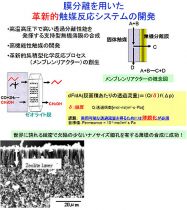Research into inorganic separation membranes
2012-1029-02

- researcher's name
-
about researcher MATSUKATA, Masahiko Professor
- affiliation
-
Faculty of Science and Engineering School of Advanced Science and Engineering
- research field
-
Catalyst/Resource chemical process,Properties in chemical engineering process/Transfer operation/Unit operation,Reaction engineering/Process system,Inorganic industrial materials,Nanostructural chemistry
- keyword
-
background
The problems associated with energy, resources and the environment are the major issues of the 21st century not only in Japan, but throughout the world. To address these issues, research is being carried out at the Matsukata Laboratory into the science and engineering of catalytic chemistry, membrane separation engineering and energy chemistry. In particular, effort has focused on research into the synthesis and catalysis of micro/meso-porous materials, their use as separation membranes, and the development of processes for making effective use of coal and waste materials.
summary
■ Compared to traditional processes that make use of phase changes such as cryogenic separation, the separation process through a zeolite membrane enables energy savings. As shown in Fig. 1, zeolite has a separation function that makes use of differences in molecular size and adsorptive power. We were the first in the world to develop an inorganic membrane that achieved separation at a molecular level, and we have continued our research in this area. We developed a practical method of forming a thin zeolite membrane on a porous support. We also developed a unique characterization method of evaluating the structure of their inorganic porous membranes and separation performance, a part of which we are trying to turn into products.
application/development
We are aiming to find industrial applications for our separation membranes, and as for dehydration membranes for isopropyl alcohol and acetic acid, we have launched an industry-academia collaboration project. Regarding the dehydration membrane for isopropyl alcohol, we ran performance evaluation tests using actual solutions on-site at a factory between 2012 and 2014. We are trying to expand application of this separation technology for use on a variety of other mixtures (gases and liquids). In addition, we are trying to apply it to membrane reactors that combine reactions with separation.
predominance
We were the first in the world to develop an inorganic membrane that achieved separation at a molecular level. We have technology for forming zeolite membranes, and methods of evaluating their structures.
purpose of providing seeds
Sponsord research, Collaboration research, Technical consultation
remarks
■ Awards won: Awards won include the Award for Young Scientists of The Society of Chemical Engineers, Japan, the Award for Young Scientists of The Japan Petroleum Institute, Award for Young Scientists of the Catalysis Society of Japan, and the Japan Institute of Energy Award for Progress.
■Membership in societies: Japan Chemical Industry Association, The Society of Chemical Engineers, Japan, The Japan Petroleum Institute, the Japan Association of Zeolite, the Japan Society of Energy and Resources, Catalysis Society of Japan, American Chemical Society, The Chemical Society of Japan, Materials Research Society、American Institute of Chemical Engineers, and The Membrane Society of Japan.
material
same researcher's seeds
-
 Synthesis of Ordered Porous Materials and Catalytic Chemical Applications
Synthesis of Ordered Porous Materials and Catalytic Chemical Applications -
 Development of cleaning agents for water and soil using inorganic materials
Development of cleaning agents for water and soil using inorganic materials
posted:
2014/05/21
